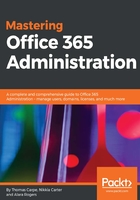
Office 365 portal
The first and most familiar way you'll find for interacting with users in Office 365 is in the Office 365 portal itself. For basic and simple one-off tasks, you will probably find it faster to use the website rather than any other method. However, keeping track of the distinctive features will require frequent use and attention, since Microsoft is constantly improving and changing the way the portal works. Case in point—Microsoft changed this tile display some time back, removing the familiar but larger metro tiles. The look and feel of the interface will often change as part of the user experience:

Admin portal icon
You can find the Admin portal in your Apps, or you can bookmark this link to create a shortcut that goes directly to it: https://portal.office.com/adminportal/home#/homepage.
Once in the Office 365 portal, navigate to Azure AD by clicking Users or Groups directly under Home in the left-hand navigation, as shown:

Navigating to admin portal users and groups
You can also link directly to each by using these URLs:
- https://portal.office.com/adminportal/home#/users
- https://portal.office.com/adminportal/home#/groups
The relevant subnavigation sections and their purposes are:
- Users:
- Active users: Shows all accounts that are active in the system, even those where login is denied.
- Contacts: Contacts can be used in certain cases to send emails to people outside the organization. They are stored in the Exchange online admin portal.
- Guest users: These are external users who have been invited into your tenant using a Microsoft account or similar mechanism.
- Deleted users: These are accounts in the end user recycle bin. More on this later.
- Groups:
- Groups: Primary view to create and manage Office 365 Groups, distribution lists, mail-enabled security groups, and regular security groups.
- Shared mailboxes: While, strictly speaking, Shared mailboxes is not a group, this area was created to simplify administration and offer the chance to create an Office 365 Group or distribution list instead. Shared mailboxes themselves are traditionally managed in the Exchange Online admin center.
We'll talk about each one in detail as we explore common activities you'll perform with users and groups throughout the rest of the chapter.